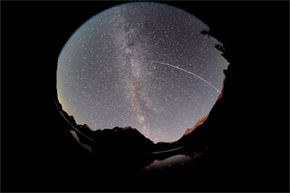How Can I See an Overhead Satellite?
When you think of stargazing, you probably picture someone standing behind a telescope, studying the craters on the moon, the spots and streaks of the rusty Martian surface, the rings of Saturn or the galaxies of the Local Group. But many amateur astronomers, even those without expensive optics, take great pleasure in spotting satellites in orbit around Earth. If you want to get in on the action, here are a few tips:
- First, you can spot satellites without any instrument at all, but it helps to have a good pair of binoculars. After that, it's a matter of going out at the right time -- just after sunset or just before sunrise, when it's dark on the ground but the sun's rays still reach the lofty altitudes where satellites reside.
- Choose a chair that allows you to recline comfortably and orient it so you can see a wide expanse of the sky. It doesn't matter which direction you face.
- Sweep slowly across the sky, pausing occasionally to focus on one area. If you're patient, you'll soon be able to spot a bright point of light moving slowly against the backdrop of stars. You can't really confuse satellites with meteors or airplanes because the former streak rapidly across the sky before burning out and the latter are usually accompanied by blinking lights and engine noise. Satellites move steadily and intently, often taking three to five minutes to travel from one horizon to the other.
- You can expect to see 10 to 20 satellites in the hour after twilight. They often travel west to east, but a few move north to south or south to north. These could be surveillance satellites used to spy on other countries.
If you want to get more serious, you can try to predict when a specific satellite will be passing overhead. Special satellite software, available for personal computers, predicts satellite orbits. The software uses Keplerian data to forecast each orbit and shows when a satellite will be overhead. The latest "Keps" are available on the Internet for a number of popular satellites. Satellites use a variety of light-sensitive sensors to determine their position. The satellite transmits its position to the ground station.
Advertisement
Of course, no "sat-seeing" expedition would be complete without a glimpse of some special satellites. Tumbling spacecraft are one such treat. These are typically dead satellites that remain in orbit but now spin around one or more axes. As they rotate, their surfaces reflect sunlight, making the objects appear to flash as they move across the sky. Satellites in the Iridium constellation can also provide a similar experience. The so-called Iridium flares occur because each satellite has an unusual six-sided shape that readily bounces light toward Earth-based observers. A single flare can glow with an apparent magnitude much greater than Venus.
The International Space Station (ISS), because of its massive size, also glows as brightly as Venus or Jupiter. But it can be challenging to see because it stays close to the horizon and passes through "spells of visibility" -- times when it's easier to spot than others. Sources like Heavens Above can tell you when and where to look to catch a glimpse of the ISS. You will need your coordinates for longitude and latitude, available from theU.S. Geological Survey, and an accurate measure of the time.
